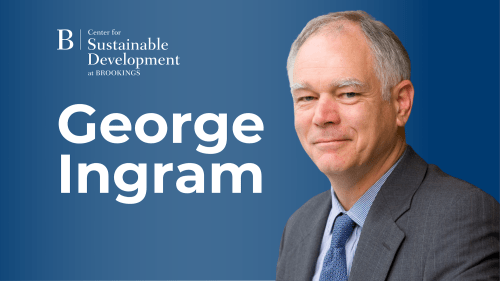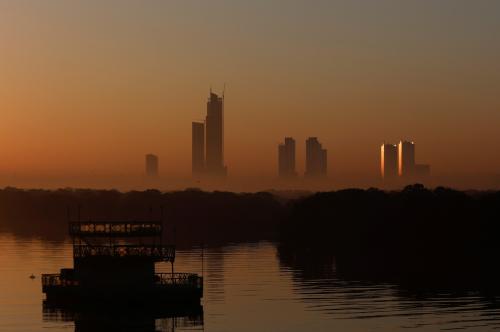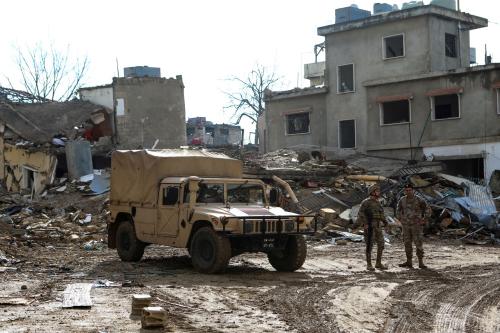Content from the Brookings Doha Center is now archived. In September 2021, after 14 years of impactful partnership, Brookings and the Brookings Doha Center announced that they were ending their affiliation. The Brookings Doha Center is now the Middle East Council on Global Affairs, a separate public policy institution based in Qatar.
Editor’s note: This piece was also published on The Huffington Post.
In a three-hour lightening assault launched on the evening of Thursday 28 May, a coalition of Syrian opposition fighters successfully captured the last remaining major regime-held town in the governorate of Idlib. In taking control of Ariha, the largely Islamist Jaish al-Fateh coalition and its allied Free Syrian Army (FSA) factions have successfully imposed a near-total province-wide strategic defeat upon the Bashar al-Assad regime.
With Idlib therefore effectively out of regime control — with the exception of the now isolated Abu Duhour Airbase and several small pockets of villages — opposition attention can now shift south to Hama, west to the regime stronghold of Latakia, and east to Syria’s largest city of Aleppo. All seem likely candidates.
Parts of northern Latakia are now dangerously exposed and one of the leading Islamist commanders active there has told this author to expect “a lot of surprises” in the coming weeks. Other insurgent commanders say a large multi-group operations room is in the midst of being formed in Aleppo amid escalating fighting south of the city. “We’re feeling more confident than ever and sooner or later, the regime will experience the consequences of that — Idlib was just the first stage of a more comprehensive plan,” claimed one prominent Islamist commander now in Idlib. However, a renewed Islamic State (IS) offensive north of Aleppo may prove a dangerous distraction to the implementation of the next stages of that more ‘comprehensive plan.’
A majority of the media coverage of Jaish al-Fateh’s advances across Idlib has focused on the role of al Qaeda affiliate Jabhat al-Nusra over and above the part played by Syrian opposition factions. Admittedly, Jabhat al-Nusra and its close ally Jund al-Aqsa have indeed played a key role in frontline operations in Ariha and previous battles in Idlib city, Jisr al-Shughour, Al-Mastouma and many other Idlib fronts. However, according to interviews with multiple commanders involved in Jaish al-Fateh operations, it has in fact been more expressly Syrian factions that have lent the most combined manpower and led much of the decision making within the operations room. Faylaq al-Sham and Ahrar al-Sham — two groups increasingly close at both leadership and ground level — have been particularly central. Moreover, none of the major victories in Idlib since early-April would have been possible without the crucial rearguard actions of U.S. — and Western-backed FSA units and their externally-supplied artillery shells, mortars and American-manufactured BGM-71 TOW anti-tank missile systems.
Thus the reality on the ground is more complex than YouTube videos and media headlines would suggest. As this author revealed in early May, the depth of coordination between Western-backed FSA factions, Islamists, Jabhat al-Nusra and other jihadists has increased markedly in Idlib since April, both due to a natural need for cooperation on the ground, but also thanks to a tacit order to do so from the U.S.- and Saudi-led coordination room in southern Turkey. Having spoken extensively with leading commanders from across the Syrian spectrum in recent weeks, it is clear this cooperation has at least partly been motivated by a desire to ensure victories in Idlib do not become strategic gains for al Qaeda. After all, it has been starkly clear since the summer of 2014 that Idlib in particular represents Jabhat al-Nusra’s most valuable powerbase.
“Coming out”
So what does Jabhat al-Nusra actually represent today? The group has evolved significantly throughout its existence in Syria and it is a well-known reality that a strong dose of pragmatism has ingratiated Jabhat al-Nusra with the opposition at large since late-2012. Its prominent role in fighting against the Islamic State (IS) from early-2014 also lent it a very ironic ‘anti-extremist’ image for many Syrians.
However, while Jabhat al-Nusra continues to appear to the outside world as a united and powerful actor in Syria, it has since mid-2014 been enduring a consequential internal struggle to define its identity. The catalyst behind this struggle was a combination of IS’ dramatic gains in Iraq, the IS declaration of a Caliphate and IS’ comprehensive defeat of Jabhat al-Nusra forces in Syria’s oil-rich eastern governorate of Deir ez Zour – all in the summer of 2014. This presented an existential challenge to Jabhat al-Nusra and to its overarching al Qaeda central leadership in Pakistan.
The immediate consequence was an internal leadership shift, with deputy leader Maysar Ali Musa Abdullah al-Juburi — better known as Abu Mariya al-Qahtani — being demoted and replaced by a Jordanian cleric, Dr. Sami al-Oraydi. As an Iraqi national from Mosul, Abu Mariya had joined al Qaeda in Iraq (AQI) in 2004 and was a founding member of Jabhat al-Nusra alongside its leader Abu Mohammed al-Jolani in Syria in August-September 2011. His experience in Syria has brought out a more pragmatic stance than what would be typical of veteran AQI commanders. Consequently, his leadership of Jabhat al-Nusra in Deir ez Zour saw his men cooperating with groups of all kinds, including quietly with tribal militias involved in cigarette smuggling. The loss of Deir ez Zour to IS thus came as a personal defeat for Abu Mariya, whose replacement was a well-known hardliner — Oraydi — whose judicial rulings have maintained a particularly harsh tone towards anyone deemed insufficiently devout or Islamist.
Sami al-Oraydi’s rise to prominence came at the same time as veteran Syrian al Qaeda figures Abu Firas al-Suri and Abu Hammam al-Suri were being thrust into the public spotlight as Jabhat al-Nusra’s official spokesman and military leader, respectively. Both men maintained strong links back to Al-Qaeda’s core leadership in Pakistan, as did a growing number of more secretive al Qaeda veterans who had been arriving in northern Syria from Afghanistan, Pakistan, Iran, Yemen and Saudi Arabia since the late summer of 2013. This latter component is what the U.S. government labeled the “Khorasan Group” in September 2014.
As Oraydi took the reigns as deputy and the broader leadership took on a more publicly visible al Qaeda image, Jabhat al-Nusra sought to exploit its advantageous position within the broader insurgency and emerge from its pragmatic posture as a more defiantly jihadist organization. “That was a dangerous time…people were afraid of IS spies and others began fearing American strikes,” said one Salafist based in Aleppo. “Nusra’s leaders began talking more assertively, especially in the north, but it was better to be with them than be their enemy.”
This ’emergence’ became most apparent in Idlib, where much of Jabhat al-Nusra’s senior leadership and ‘Khorasan’ figures had settled. Through September and October 2014, as coalition airstrikes began and continued to sporadically target apparent ‘Khorasan’ facilities, Jabhat al-Nusra led the comprehensive defeat of the famed U.S.- and Saudi-backed Syrian Revolutionaries Front (SRF) led by Jamal Maarouf, which it had accused of corruption. This ‘anti-corruption’ drive extended beyond Idlib, into areas of Homs, Hama, Aleppo, and further south in Damascus and Deraa.
Specifically in Idlib, Jabhat al-Nusra also began unilaterally imposing a harsher level of Sharia justice, including stoning men and women to death, restricting women’s dress and freedom of public movement, and enforcing the closure of shops during prayer time. Two well-connected Islamists active in northern Syria even claimed that a hardline faction of Jabhat al-Nusra had been responsible for the dramatic killing of much of Ahrar al-Sham’s senior leadership in rural Idlib on 9 September 2014 – as an attempt to prevent Ahrar’s public political moderation. The group’s official position, however, is that no perpetrating party has yet been identified.
This ‘real’ face of Jabhat al-Nusra continued to be evident into early-2015, when it most notably defeated and forced the total dissolution of another Western-backed group, Harakat Hazm. “That’s when we saw what Nusra really represents,” said one FSA activist whose family is from Idlib. “They only want to seek their own objectives, no matter the cost to the revolution.” But not all saw it the same way, especially when it came to the fighting against the SRF and Harakat Hazm. One FSA commander exclaimed to this author that “Jamal Maarouf was a criminal and his group was unpopular,” while another such leader told this author in February 2015 that “Hazm’s destruction cannot come soon enough, they have done nothing but cause trouble in Aleppo.”
‘Re-moderation’
By early-2015, Jabhat al-Nusra was sitting comfortably, after defeating the two foreign-backed groups it most feared could turn against it in northern Syria and after consolidating its position of strength in Idlib. However, its boldly aggressive behavior from September 2014 had led to increasing anxiety within the entire opposition about the real nature of Jabhat al-Nusra and its long-term intentions in Syria. Senior leaders of Islamist groups as hardline as Ahrar al-Sham have expressed to this author repeatedly and on separate occasions their concern that Jabhat al-Nusra was walking down ‘the wrong path’ — in other words, that it was displaying too much of al Qaeda’s transnationalism and extremism than would be acceptable within the Syrian revolution.
Some of these concerns made their way to Jabhat al-Nusra, two Salafist sources have confirmed, and came on the heels of a secret order sent from al Qaeda leader Ayman al-Zawahiri in early-2015 that outlined a new and comprehensive strategy for Jabhat al-Nusra in Syria. According to two well-connected Syrian Islamists with connections into Jabhat al-Nusra, Zawahiri specifically called on Jolani to better integrate his movement within the Syrian revolution and its people; to coordinate more closely with all Islamic groups on the ground; to contribute towards the establishment of a Syria-wide Sharia judicial court system; to use strategic areas of the country to build a sustainable Al-Qaeda power base; and to cease any activity linked to attacking the West. Both sources confirmed that Jolani subsequently distributed Zawahiri’s instructions across Jabhat al-Nusra’s leadership structure and on 27 May, Jolani revealed publicly the last instruction during an extended interview with Al-Jazeera.
Such a pragmatic posture, coming immediately after a period of more overt assertion of traditional al Qaeda behavior, has opened up a potentially consequential division within Jabhat al-Nusra. “There are now two main currents…the conservatives are keen on keeping ties to Al-Qaeda and the others are more inclined towards the new Syria-focused approach,” according to one of the well-placed Islamists. Some of the so-called ‘Khorasan Group’ went on to obey Zawahiri and Jolani’s orders and integrated their activities into Jabhat al-Nusra’s Idlib offensive from mid-March 2015 — as Martin Chulov also revealed on 28 May. Others have isolated themselves and continued to focus on external plots – these individuals are thought to have retained the interest of U.S. strikes, two of which struck al Qaeda-linked targets in Idlib on 20 May. One of those strikes killed U.S.-designated Algerian jihadist Said Arif, who had initially joined Jabhat al-Nusra but had since become the military leader of Jund al-Aqsa — thereby revealing the increasingly close and at times inter-related nature of Jabhat al-Nusra and Jund al-Aqsa in northern Syria.
Jabhat al-Nusra’s moderating shift quickly gained the support of people like Abu Mariya, who had been calling for a more strategically focused approach. “Abu Mariya is considered [to be] within Jabhat al-Nusra’s internal opposition, but he’s actually a little isolated,” claimed one senior Salafist. Other leaders supposedly on board with Jolani’s order allegedly include the Australian Abu Sulayman al-Muhajir. It was within this evolving environment in early-2015 that Qatar allegedly sought to force Jolani to break his group’s allegiance from al Qaeda, in such a way as to allow external bodies to provide the group with support.
However, the re-moderation has been a divisive move and conservative elements within Jabhat al-Nusra are allegedly increasingly discontent. One Islamist official from Damascus described the dilemma clearly:
“Jabhat al-Nusra’s disengagement from al Qaeda would be good for the revolution, but Jabhat al-Nusra will always be in dire need of al Qaeda’s name to keep its foreign fighters away from IS. Most Jabhat al-Nusra foreign fighters will never accept to fight and die for what looks like an Islamic national project.”
Within the context of Jabhat al-Nusra’s internal discord, an Islamist from Aleppo added that “nothing [bad] has happened yet, because it’s proven a positive move, just look at what’s been achieved in Idlib since,” as one Islamist put it. Should Jabhat al-Nusra’s attempt at moderation and integration with the broader opposition continue to bear fruit on the battlefield, then it seems likely any internal backlash will be minimized, but should progress slow, the ruptures currently spoken about only behind closed doors may begin to emerge more publicly. “I know what’s going on inside Jabhat al-Nusra,” said another Salafist source, “[Jolani] was trying to come up with a new discourse [in his Al-Jazeera interview] but he didn’t fully make it. He wants to be progressive, but he’s still torn between the two worlds.”
For now, moderation or not, Jabhat al-Nusra must still be viewed as an avowed member of al Qaeda — an organization whose express objective remains to attack and destroy the Western world. Jolani’s interview may have appeared to some as having revealed more moderate positions on issues like minorities, strict Sharia law, and hostilities with the West, but all such positions were limited to the conditions prevalent today — war. Should the Assad regime one day fall or be pushed aside in a negotiated political transition, al Qaeda’s true colors will surely be revealed.
If for that reason only, the international community must view Jabhat al-Nusra’s cunning positioning as part of a long-term plan. Syria is on Europe’s doorstep and our 20-year enemy, al Qaeda, is outbidding us and appropriating the support of many of those who could otherwise have been our friends.
The Brookings Institution is committed to quality, independence, and impact.
We are supported by a diverse array of funders. In line with our values and policies, each Brookings publication represents the sole views of its author(s).



Commentary
An internal struggle: Al Qaeda’s Syrian affiliate is grappling with its identity
May 31, 2015